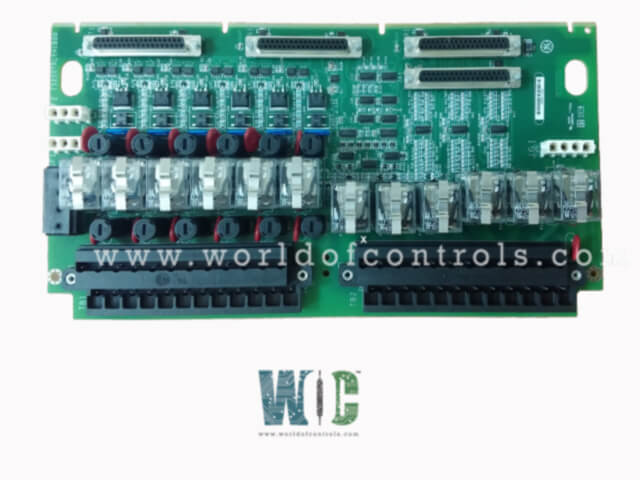
World Of Controls understands the criticality of your requirement and works towards reducing the lead time as much as possible.
IS200TRLYH1B - Relay Output Terminal Board is available in stock which ships the same day.
IS200TRLYH1B - Relay Output Terminal Board comes in UNUSED as well as REBUILT condition.
To avail our best deals for IS200TRLYH1B - Relay Output Terminal Board, contact us and we will get back to you within 24 hours.
Part No.: IS200TRLYH1B
Manufacturer: General Electric
Country of Manufacture: USA
Product Type: Termination Relay Card
Series: Mark VIe
The IS200TRLYH1B is a Relay Output Terminal Board developed by GE under the Mark VIe series. There are 12 plug-in magnetic relays on the Relay Output with Coil Sensing (TRLY1B) terminal board. The first six relay circuits can be set up with jumpers to drive external solenoids or dry, Form-C contact outputs. For field solenoid power, a basic 125 V dc or 115/230 V ac source or an optional 24 V dc source with personal jumper-selectable fuses and onboard suppression can be offered. The next five relays (7–11) are isolated Form-C contacts that are not powered. An isolated Form-C contact is used on output 12 for specialized uses like ignition transformers.
Simplex and TMR applications are supported by the PDOA/YDOA I/O pack when using the TRLY 1B. The terminal board's DC-37 pin connections accept the I/O pack as a plug-in. For simplex systems, connector JA1 is used, while for TMR systems, connectors JR1, JS1, and JT1 are used.
Wire the two I/O terminal blocks on the terminal board, TRLY1B Terminal Board Wiring, directly with the wires for the 12 relay outputs. Each block has 24 terminals that may accommodate wires up to #12 AWG and is secured with two screws. Each terminal block has a shield terminal strip on the left side that is connected to chassis ground. The solenoid power for outputs 1-6 should be connected to JF1. Power can be daisy-chained to additional TRLYs using JF2. Alternatively, when JF1/JF2 are not in use, power can be connected directly to TB3.
Connect output 12 of the special solenoid to connector JG1 to provide electricity. The factory removes jumpers JP1-JP6 and ships them in a plastic bag. If a field solenoid needs electricity, reinstall the proper jumper. Check each loop's energization individually in accordance with best practices, and install the jumpers as necessary. Remove the fuses from isolated contact applications to make sure that the power bus is free of suppression leakage.
If these terminal boards are utilized as dry contacts to switch ac voltage utilizing circuits 01 through 06 while also receiving 125 V dc power through JF1, JF2, or TB3, ac power will be present on the "NO" relay terminal until all fuses and jumpers for a circuit are removed. Additionally, the contact will bind the ac voltage to N 125 V dc when it shuts.
Similar circumstances apply to the P-125. The sum of the ac peak voltage and the 125 V dc is applied to MOVs linked between the dc and ground because the neutral of the majority of ac supply is grounded. The MOV rating is adequate to tolerate 120 V ac in those situations. The peak voltage will, however, exceed the MOV rating in 240 V ac applications, leading to failure. It is best to avoid using these circuits for ac switching because of this.
On the TRLY 1B are mounted jumpers, fuses, and relay drivers. D-type connectors monitor feedback voltages and transmit control signals between the I/O processors and TRLY1B through JA1 for simplex operation. Relays have a 3.0 A rating and are driven at the frame rate. 500 V ac is the maximum allowable contact-to-contact voltage for one minute. For one minute, the coil to contact voltage is rated at 1,500 V ac. 10 ms is the normal operating time.
Relay control signals are fanned into TRLY1B for TMR applications from the three I/O processors R, S, and T through connectors JR1, JS1, and JT1. These signals are put to a vote, and the outcome determines which relay driver gets the signal. All three I/O processors provide shared diode power to the relay coils.
Number of relay channels on one TRLY1B board
The rated voltage on relays
Max load current
Max response time on
25 ms typical
Max response time off
25 ms typical
The following diagnostic procedures are performed on the terminal boards' components:
The most extensive assortment of GE Speedtronic Mark VIe control replacement components can be found at World of Controls. Please get in touch with WOC if you require any additional information.
What is IS200TRLYH1B?
The IS200TRLYH1B is a Termination Relay Card developed by GE under the Mark VI series.
How many terminal blocks are there on IS200TRLYH1B?
The board possesses two black terminal blocks.
How to Obtain IS200TRLYH1B?
WOC provides OEM turbine control products. Contact World of Controls.